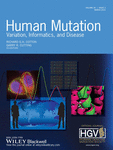Does IARS2 Deficiency Cause an Intrinsic Disorder of Bone Development (Skeletal Dysplasia) or Are the Reported Skeletal Changes Secondary to Growth Hormone Deficiency and Neuromuscular Involvement?
To the editor,
Schwartzentruber et al. [2014] and Deal et al. [2012] recently reported three patients with mitochondrial isoleucyl aminoacyl-tRNA synthetase (IARS2; MIM #612801) variants resulting in cataracts, growth hormone deficiency, sensory neuropathy, sensorineural hearing loss, and skeletal dysplasia. Acronymous titles are a familiar and useful way to remember the characteristic phenotypes of patients with mitochondrial disorders, exemplified by the best known mitochondrial phenotype, mitochondrial encephalopathy, lactic acidosis, and stroke-like episodes [Pavlakis et al., 1984].
However, the presence of primary skeletal (spondylo-epiphyseal) dysplasia is questionable in these patients. Primary skeletal dysplasias have been defined as disorders with inborn or constitutional abnormalities of bone development and remodelling [Warman et al., 2011]. The most recent skeletal dysplasia classification from 2009 does not list any primary skeletal dysplasia due to an underlying defect in mitochondrial biogenesis or function [Warman et al., 2011] and we are not aware of any mitochondrial disorders causing primary skeletal dysplasia that have been published subsequently. Secondary changes in skeletal morphology and density are common in the context of mitochondrial disorders. These patients appear to have secondary skeletal changes due to developmental dysplasia of the hip, with otherwise minor skeletal changes. The diffuse cervical spinal stenosis and hypoplasia of C2-odontoid is more difficult to discount; however, these changes can be observed in the context of low bone density.
Schwartzentruber et al. [2014] also review the phenotype of the biochemically linked isoleucyl-tRNA (MT-TI; MIM# 590045) and cite hypertrophic cardiomyopathy as the recognized phenotype. A list of mitochondrial phenotype–genotype relations is curated at MitoMap [Ruiz-Pesini et al., 2007]. This list identifies hypertrophic cardiomyopathy, fatal infantile cardiomyopathy plus, skeletal myopathy, chronic progressive ophthalmoplegia, progressive encephalopathy, sudden infant death syndrome, diabetes mellitus, hypomagnesemia, and deafness as reported phenotypes. Therefore, the phenotypic spectrum of this related disorder is very wide. Primary skeletal dysplasia has not been a reported phenotype. Moreover, skeletal dysplasia has not been a reported feature of any cytoplasmic tRNA or aminoacyl-tRNA synthetase defect. Clinical heterogeneity of MT-TI disorders can be explained by heteroplasmy rate, tissue distribution, oligogenic, and environmental factors. Perhaps residual mitochondrial respiratory chain and aminoacyl-tRNA synthetase enzyme activity can be studied in future patients to determine whether differences in these may contribute to phenotypic variability?
Thus, these patients either represent the first reported mitochondrial cause of primary skeletal dysplasia or the observed changes are secondary, or are due to a concurrent disorder of vertebral development.




